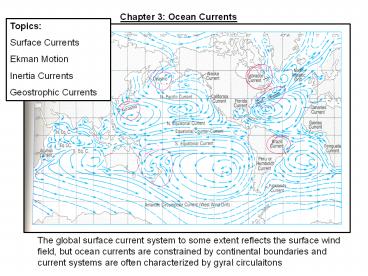Chapter 3: Ocean Currents PowerPoint PPT Presentation
Title: Chapter 3: Ocean Currents
1
Chapter 3 Ocean Currents
Topics Surface Currents Ekman Motion Inertia
Currents Geostrophic Currents
The global surface current system to some extent
reflects the surface wind field, but ocean
currents are constrained by continental
boundaries and current systems are often
characterized by gyral circulaitons
2
The frictional force caused by the action of wind
on the sea-surface is known as the wind stress.
Its magnitude is proportional to the square of
the wind speed it is also dependent on the
roughness of the sea-surface and conditions in
the overlying atmosphere.
t cW2
Stokes drift
Energy from the atmosphere can go toward building
waves and/or generating currents Surface currents
3 of the wind speed
3
turbulent flow --gt transfer by eddy viscosity
- a property of the flow
laminar flow --gt transfer by molecular viscosity
- a property of the fluid
Motion is transmitted downward through frictional
coupling caused by turbulence. Coefficient of
friction important for ocean studies
coefficient of eddy viscosity Az 10-2 102
kg/(ms) Ah 104 108 kg/(ms) Magnitude of
eddy viscosity depends on stratification of the
water column - the stronger the (stable)
stratification the more turbulent mixing gets
suppressed. Conversely, in a homogeneous fluid
turbulence mixes very efficiently. Try to answer
Question 3.3
4
Key Concepts Moving water tends toward a
situation of equilibrium. Flows adjust to the
forces acting on them so that those forces
balance one another. The major forces that need
to be considered with respect to moving water
are Wind stress at the sea surface, internal
friction, the Coriolis force and horizontal
pressure gradient forces. For boundary flows
friction with the seabed or coastline may need to
be considered.
Ekman Motion wind stress and internal Friction
balanced by Coriolis force
5
Ekman Motion
Ideal Ocean Inf. Deep Inf. Wide No variation
in density Surface remains horizontal
Surface currents move 45o to the right/left of
the wind in the NH/SH. Mass transport in the
Ekman Layer is 90o to the right/left of the wind
in the NH/SH
6
Ekman Motion
Ekman Surface Current Speed uo t
/r(Azf)1/2 uo current speed Az vertical eddy
viscosity t wind stress r density of
seawater f Coriolis Parameter
Coriolis Force m x 2W sin(f) x u m mass u
speed f latitude W angular velocity of
Earth 2W sin(f) Coriolis Parameter (f)
Remember that all physical variables and
quantities have units!! Write the units of all
quantities above, use the metric system. Surface
currents move 45o to the right/left of the wind
in the NH/SH. Mass transport in the Ekman Layer
is 90o to the right/left of the wind in the NH/SH
7
Ekman Motion
Depth Mean Current u t /(Drf) uo current
speed D depth of the Ekman Layer t wind
stress r density of seawater f Coriolis
Parameter
D (2p2Az/f)1/2
In the Ocean the thickness of the Ekman Layer is
less than the thickness of the mixed layer (100
200 m). Would you have an Ekman Layer extending
up from the seabead?
8
Hydrostatic Pressure p -rgz z depth g
grav. Acc. r density of seawater
PGF per Unit Mass 1/r x dp/dx g x tan(q)
9
(No Transcript)
10
Divergence and Convergence Wind stress on the
surface of the water will induce both horizontal
and vertical movement of water Upwelling deeper
water transported to the surface Downwelling
surface water converges and sinks to lower layers
11
Ekman Pumping
12
Subtropical Ocean Gyres result from the
general/mean atmospheric circulation Centered
between 10o 40o latitude Think through the
steps and various forces that interplay in the
generation of the gyres windstress (global wind
belts), friction, coriolis force, Ekman, pressure
gradient, depression of the thermocline and
downwelling
13
Subtropical/Subpolar gyres
14
Eddies equivalent to atmospheric storms,
cascade of energy flow from large scale
features down to the molecular level
Mesoscale Eddies 50-200 km 1 several
months Geostrophic u 0.1 m/s
Ultimately the oceans kinetic energy is
converted to heat, through frictional interaction
with the sea-bed or internal friction at the
molecular level (molecular visc.)
15
Time Space Energy Scales of Different Motions

